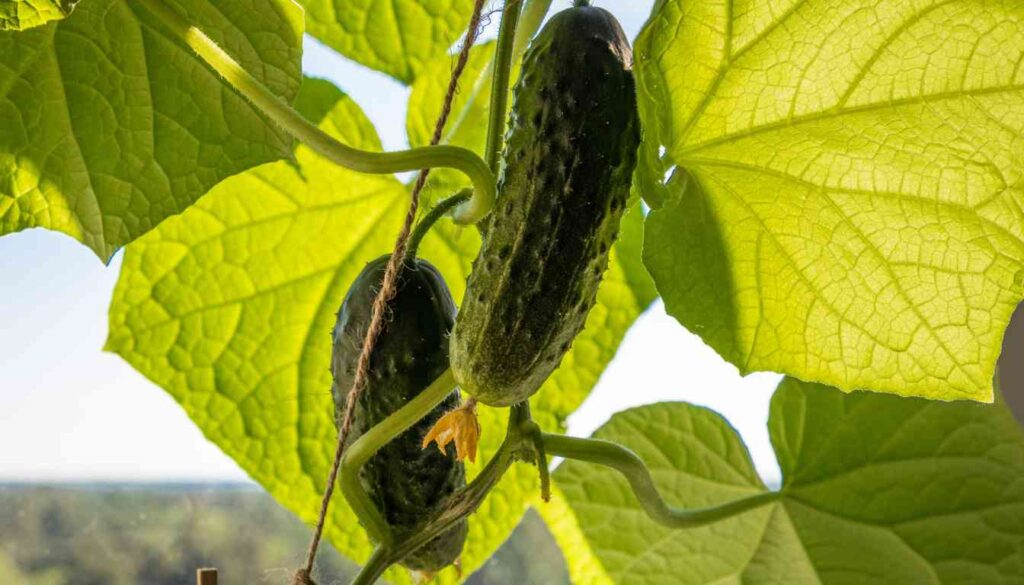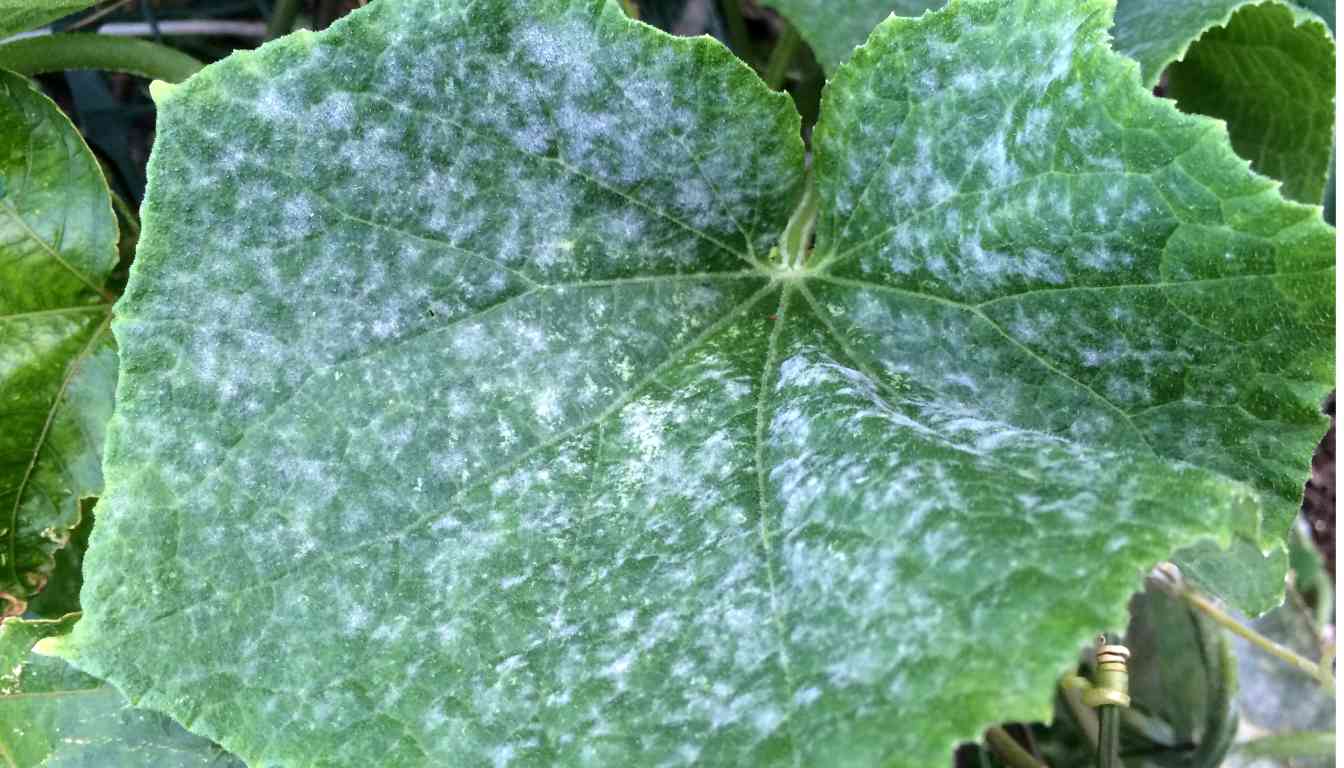Paul Johnston is the founder and master herbalist of The Herb Prof, with decades of clinical experience in naturopathic medicine, herbal remedies, detoxification and holistic wellness. After overcoming his own serious health challenges, he now dedicates himself to helping others reclaim their health naturally.
I recently spotted white marks on my cucumber leaves and immediately grew concerned about the health of my garden. After doing some research, I discovered that this is a common problem many gardeners face, with several possible causes. In this article, I’ll explain what I learned about white spots on cucumber leaves and how to deal with them effectively.
Cucumbers are a popular vegetable among gardeners, but they can be susceptible to various diseases and pests. One of the most common problems is white spots on cucumber leaves. These spots can be caused by fungal diseases like powdery mildew or bacterial infections like angular leaf spot. Additionally, environmental factors like high humidity and poor air circulation can contribute to the growth of white spots on cucumber leaves.
As a gardener, it is important to identify the cause of white spots on cucumber leaves to properly address the issue. In the following sections, I will provide more information on the causes of white spots on cucumber leaves and how to prevent and treat them.
Understanding the Cause of White Spots on Cucumber Leaves
As a gardener, seeing white spots on cucumber leaves can be alarming. These spots can be caused by various factors, but the most common culprit is powdery mildew. Understanding the cause of white spots on cucumber leaves is essential to prevent the spread of the disease and ensure the health of your plants.
Identifying Powdery Mildew
Powdery mildew is a fungal disease that affects a wide range of plants, including cucumbers. It is caused by two types of fungi: Erysiphe and Podosphaera. The disease manifests as white spots on the leaves, stems, and fruit of the plant. These spots can spread quickly and cover the entire plant if left untreated.
Factors That Contribute to Its Spread
Powdery mildew thrives in warm, humid conditions. High humidity and temperatures between 60-80°F provide the perfect environment for fungal spores to germinate and spread. Poor air circulation also contributes to the spread of the disease. When plants are crowded, air cannot circulate properly, and humidity levels rise, creating an ideal environment for powdery mildew to thrive.
Other Potential Issues
While powdery mildew is the most common cause of white spots on cucumber leaves, other issues can also cause this symptom. Bacteria and other fungal diseases, such as downy mildew, can also cause white spots on cucumber leaves. Pests, such as spider mites, can also damage the leaves, causing white spots to appear.
In summary, white spots on cucumber leaves are most commonly caused by powdery mildew. Understanding the factors that contribute to the spread of this fungal disease can help you prevent and treat it effectively. Keeping your garden well-ventilated, maintaining proper humidity levels, and monitoring your plants for signs of disease or pests are essential steps to ensure the health of your cucumber plants.
Treatment for Powdery Mildew
If you have noticed white spots on your cucumber leaves, your plants have likely been infected with powdery mildew. Fortunately, there are several treatment options available that can help you combat this fungal disease and prevent it from spreading to other plants in your garden.
Using Plant Disease Resistant Varieties
One effective way to prevent powdery mildew is to choose cucumber varieties that are resistant to this disease. Disease-resistant varieties are genetically modified to be more resistant to powdery mildew and other common plant diseases. By planting these varieties, you can reduce your risk of powdery mildew and other fungal diseases.
Adjusting Gardening Practices
Another way to prevent powdery mildew is to adjust your gardening practices. Powdery mildew thrives in warm, humid environments, so it is important to keep your garden dry and well-ventilated. Avoid overhead watering, as this can create a moist environment that is perfect for powdery mildew to grow. Instead, water your plants at the base to keep the leaves dry.
Protecting Against Pests
Pests can also contribute to the spread of powdery mildew in your garden. Insects such as aphids and whiteflies can carry the spores of powdery mildew from plant to plant, so it is important to protect your plants against these pests. Neem oil and horticultural oil are effective treatments for many common garden pests. You can also use insecticidal soap or other organic treatments to keep pests under control.
There are many treatment options available for powdery mildew, ranging from organic treatments such as baking soda to chemical fungicides. However, it is important to choose the right treatment option for your specific situation. Consider the severity of the powdery mildew infection, the size of your garden, and your personal preferences when choosing a treatment option. With the right treatment and good gardening practices, you can successfully treat powdery mildew and protect your cucumber plants from this fungal disease.
Prevention Methods
As a gardener, I always prefer to prevent problems before they occur. White spots on cucumber leaves can be prevented by taking the following measures:
Proper Plant Spacing and Mulching
Proper plant spacing is essential for good air circulation and sunlight exposure. Cucumbers need full sun to grow and thrive. I always make sure to space my cucumber plants at least 18 inches apart to allow for good airflow. Mulching is also important to keep the soil moist and cool. I use organic mulch to prevent soil-borne diseases and to keep the soil temperature stable.
Monitoring and Adjusting Watering Habits
Overwatering or underwatering can lead to white spots on cucumber leaves. I always monitor the soil moisture level and adjust my watering habits accordingly. Drip irrigation is an efficient way to water cucumbers, and it also prevents water from splashing on the leaves. If you don’t have a drip irrigation system, make sure to water the soil around the plants and not the leaves.
Using Organic Fungicides
Prevention is always better than cure, but if you notice white spots on your cucumber leaves, you can still treat them. Organic fungicides such as neem oil, horticultural oil, and baking soda solution can help prevent the spread of fungal diseases. Milk is also a natural fungicide that can be used to prevent powdery mildew. Simply mix one part milk with nine parts of water and spray on the leaves.
By following these prevention methods, you can prevent white spots on cucumber leaves and ensure a healthy and productive harvest.
Before You Go – White Spots on My Cucumber Leaves

After researching and analyzing the causes and treatments of white spots on cucumber leaves, I have gained comprehensive information on this issue. Powdery mildew is the most common cause of white spots on cucumber leaves. This fungal disease thrives in warm, humid environments and can quickly spread to other plants.
To prevent powdery mildew and other fungal diseases, it is important to maintain good growing conditions for your cucumber plants. This includes providing adequate spacing between plants, proper ventilation, and appropriate irrigation. Additionally, using disease-resistant varieties of cucumbers can help reduce the risk of infection.
When it comes to treating powdery mildew, there are several options available. One effective treatment is using potassium bicarbonate, an organic fungicide that can be applied every 7 to 10 days. Sulfur is another commonly used fungicide for targeting white spots on cucumber leaves.
It is important to be proactive in preventing and treating white spots on cucumber leaves. By maintaining good growing conditions and using appropriate treatments, you can ensure that your cucumber plants stay healthy and productive. This authoritative content will help you become a knowledgeable gardener and grow healthy cucumbers.
White Spots on My Cucumber Leaves: A Green Thumb’s Guide
Have you ever noticed white spots on your cucumber leaves? Don’t panic! Let’s dive into this.
Firstly, white spots on cucumber leaves can be a sign of common garden issues like powdery mildew or other fungal infections. But don’t worry, it’s not the end of the world for your cucumbers!
Now, you might be thinking, “How does this relate to theherbprof.com?” Well, let me tell you! Theherbprof.com is your go-to resource for all things plants. It’s like having a plant doctor at your fingertips!
So, how do these two help each other? Simple! Your cucumber plants provide the questions, and theherbprof.com provides the answers. It’s a match made in plant heaven!
Remember, every plant has a story. And at theherbprof.com, we’re all about helping you write that story. So, let’s grow together, one cucumber leaf at a time!
References – White Spots on My Cucumber Leaves
Little Herb Encyclopedia, by Jack Ritchason; N.D., Woodland Publishing Incorporated, 1995
The Ultimate Healing System, Course Manual, Copyright 1985, Don Lepore
Planetary Herbology, Michael Tierra, C.A., N.D., Lotus Press, 1988
Handbook of Medicinal Herbs, by James A. Duke, Pub. CRP Second Edition 2007
The Complete Medicinal Herbal, by Penelope Ody, Published by Dorling Kindersley
Check the Following Articles!
Monstera Adansonii Vs Monstera Deliciosa
Can You Use Regular Fertilizer for Semi Hydroponics?
Indoor Trees Low Light: Discover the Top 10 Options!
Frequently Asked Questions – White Spots on My Cucumber Leaves
1. What is the treatment for white spots on cucumber leaves?
The most common treatment for white spots on cucumber leaves is to use a fungicide. There are many different types of fungicides available, including organic and chemical options. Some popular organic fungicides include neem oil, horticultural oil, and a baking soda solution. Chemical fungicides are also available, but they should only be used as a last resort. It is important to follow the instructions on the fungicide label carefully to ensure that it is used safely and effectively.
2. Can I see images of white spots on cucumber leaves to identify the issue?
Yes, you can find images of white spots on cucumber leaves online. These images can help identify the issue and determine the appropriate treatment. Some of the best sources for images of white spots on cucumber leaves include gardening websites and forums.
3. What are the steps to eliminate white spots on cucumber leaves?
To eliminate white spots on cucumber leaves, it is important to first identify the cause of the issue. Once the cause has been identified, the appropriate treatment can be applied. In most cases, this will involve using a fungicide. It is also important to remove any infected leaves and to ensure that the cucumber plant is getting adequate sunlight and water.
4. How do you manage powdery mildew on cucumber plants?
Powdery mildew is a common fungal disease that can affect cucumber plants. To manage powdery mildew on cucumber plants, it is important to first identify the issue and determine the appropriate treatment. This may involve using a fungicide, removing infected leaves, and ensuring that the plant is getting adequate sunlight and water. It is also important to avoid overcrowding plants and to provide good air circulation around the cucumber plant.
5. Is it safe to consume cucumbers that have white spots on their leaves?
Yes, it is safe to consume cucumbers that have white spots on their leaves. However, it is important to ensure that the cucumber has been properly washed and that any infected leaves have been removed. If you are concerned about the safety of your cucumbers, it is best to consult with a medical professional.
6. Are cucumber seedlings at risk if they develop white spots on their leaves?
Yes, cucumber seedlings are at risk if they develop white spots on their leaves. This is because the white spots are often caused by a fungal disease, which can spread quickly and damage the seedling. It is important to identify the issue and apply the appropriate treatment as soon as possible to protect the seedling.

